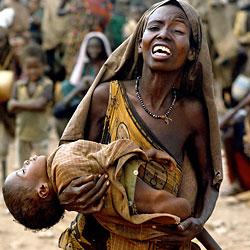Oct 13
20160
Amnesty International, Avaaz, Center for American Progress, Human Rights Watch, Humanitarian Agencies, Imperialist Wars/Occupations, National Endowment for Democracy [NED], Social Engineering, USAID, Whiteness & Aversive Racism
Amnesty International Avaaz Center for American Progress (CAP) Chad CIA DarfurGenocide.org Democratic Republic of the Congo ENOUGH Project Horn of Africa Human Rights Watch National Endowment for Democracy (NED) northern Uganda Oxfam Pax Americana Regime Change Res Publica Ricken Patel Somalia Sudan Tom Perriello UNHCR USAID “Responsibility to Protect”
Enough of CIA’s ‘Enough Project’ in Africa! [Avaaz, International Crisis Group, Center for American Progress]
Libya360 | Internationalist News Agency
Cross-posted from TeleSUR
October 7, 2016
By Thomas C. Mountain
The “Enough Project” claims it’s mission is to prevent genocide in Africa, but has been conspicuously silent when it comes to the genocidal famine in Somalia.
WKOG editor: As people finally become aware of Avaaz – as a key instrument of empire – watch for the Enough Project which could, if embraced by the public, become the new NGO assigned to create acquiescence for the destabilization of targeted countries. The Enough Project was co-founded by the Center for American Progress (see below) and the International Crisis Group in 2007. Key partners include Amnesty International, Human Rights Watch, Oxfam and UNHCR. Enough is a project of the New Venture Fund, and is based in Washington, DC. Its co-founders are John Prendergast (former Director for African Affairs at the National Security Council) and Gayle Smith (current administrator of the United States Agency for International Development).
“ENOUGH operates under the umbrella of the Democratic Party’s corporate funded propaganda and influence peddling operation, The Center for American Progress (CAP).” Former Democratic congressman and Avaaz co-founder Tom Perriello served as President and CEO of the Center for American Progress Action Fund and as a Counselor for Policy at Center for American Progress until July of 2015 when he was appointed Special Envoy for the African Great Lakes and the Congo-Kinshasa by the White House.
“The Enough Project focuses on Africa” – Sudan, Chad, Democratic Republic of the Congo, northern Uganda, and the Horn of Africa.
The Enough Project has worked hand-in-hand with Avaaz in the past.
Perriello and Avaaz co-founder Ricken Patel also co-founded and co-directed DarfurGenocide.org which officially launched in 2004. “DarfurGenocide.org is a project of Avaaz co-founder Res Publica, a group of public sector professionals dedicated to promoting good governance and virtuous civic cultures.”Today, this organization is now known as “Darfurian Voices”: “Darfurian Voices is a project of 24 Hours for Darfur.” The U.S. Department of State and the Open Society Institute were just two of the organization’s funders and collaborating partners. Other Darfurian Voices partners include Avaaz, the National Endowment for Democracy (NED), International Centre for Transitional Justice, Darfur Rehabilitation Project, Humanity United, Darfur People’s Association of New York, Genocide Intervention, Witness, Yale Law School, The Sigrid Rausing Trust and the Bridgeway Foundation. Of all the listed partners of DarfurGenocide.org, with the exception of one located in London, England, all of the entities involved are American and based on U.S. soil.
Despite the carefully crafted language and images that tug at your emotions, such NGOs were created for and exist for one primary purpose – to protect and further American policy and interests, under the guise of philanthropy and humanitarianism.
+++
Enough of the CIA’s “Enough Project” in Africa!
EP, as it is known, was founded by senior U.S. Intel “spook” Gayle Smith, former Senior Director of the National Security Council under President Obama and now head of the USAID/CIA.
Today EP is headed by Ms. Smith’s protégé John Prendergast whose history as head of EP is one of subterfuge and lies in service to Pax Americana.
EP claims it’s mission is to prevent genocide in Africa, as in the name “Enough Project”, yet has been conspicuously silent when it comes to the genocidal famine in Somalia during the Great Horn of Africa Drought in 2011-12 where 250,000 Somali children starved to death.
Recently George Clooney was enjoying 15 minutes of fame as a humanitarian claiming to have exposed massive corruption in South Sudan when he should have been warning the world of the U.N.’s next genocide in Somalia as in 300,000 starving children. Soon the genocide in Somalia will hit its peak with hundreds, up to 1,000 children a day dying from hunger with only a deafening silence emanating from the CIA’s Enough Project.
EP, with support from its big brother the Center for American Progress, only once in its history raised a real genocide, that back in 2007-8 when Gayle Smith was out to political pasture, she being a rabid democrat during the Bush Jr. years in office. Then she was part of the Democrat “opposition” to the Bush regime and oh so briefly raised the food and medical aid blockade in the Ogaden in Ethiopia, where the only instance of both the Red Cross and Doctors Without Borders being expelled from a famine stricken region has been allowed.
Once Ms. Smith jumped on the Obama For President bandwagon, no further mention of the genocide in the Ogaden was heard.

The Chinese have started to expand their oil production so expect to hear louder cries of outrage from the likes of EP about various crimes and even “genocide” in South Sudan followed by demands for more foreign military intervention in the country.
With all their lies and subterfuge, don’t you think that we here in Africa have had enough of the CIA’s Enough Project?
[Thomas C. Mountain is an independent journalist in Eritrea living and reporting from here since 2006.]
Further reading:
Imperialist Pimps of Militarism, Protectors of the Oligarchy, Trusted Facilitators of War | Part IV
http://www.anngarrison.com/audio/creating-south-sudan-george-clooney-john-prendergast-and-george-w-bush














